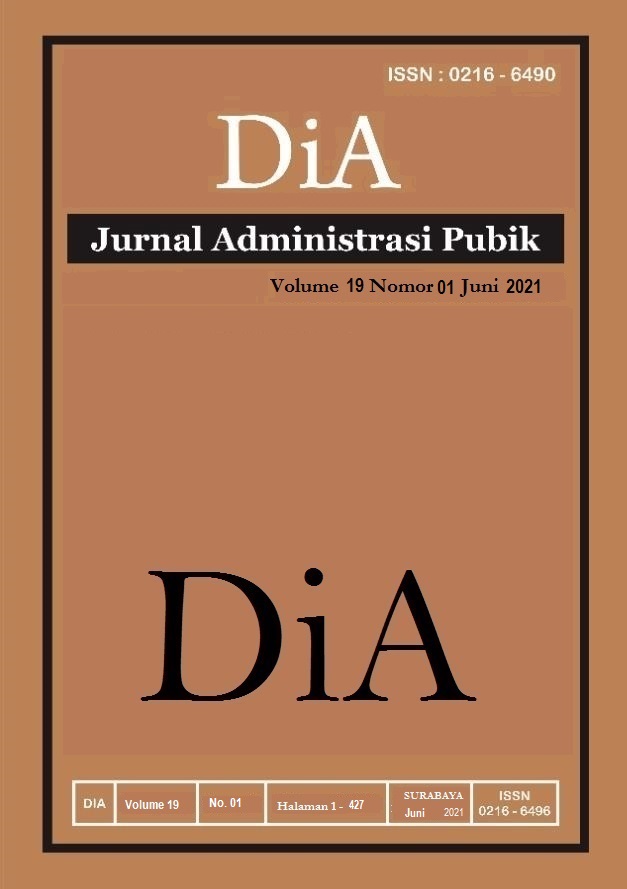COMMUNICATION EFFECTIVENESS OF SURABAYA CITY GOVERNMENT THROUGH TWITTER AND FACEBOOK
DOI:
https://doi.org/10.30996/dia.v19i1.5117Keywords:
Communication Effectiveness, Facebook, TwitterAbstract
Advances in information and communication technology encourage the government as a stakeholder to have social media accounts. Likewise, the community is also required to have social media as a means of communication. The importance of social media has a very significant impact, especially in the field of government, for example as a medium in conveying suggestions and complaints from the public to the government or vice versa. Twitter and Facebook are some of the social media that are very popular with Indonesians. Including the Surabaya City Government, to support and develop policy programs made, they use this social media tool as an effective medium of communication. The purpose of this study was to determine the level of effectiveness of Surabaya city government communication via Twitter and Facebook. The research method used is descriptive qualitative by utilizing the Nvivo application to process the data. In this study, there are several assessment indicators used as benchmarks, namely (1) Accuracy, (2) Creativity, (3) Activeness, (4) Interaction, (5) Transparency. From the research results, it is known that the effectiveness of communication via Twitter is better than Facebook in terms of accurate information, creativity, activeness, and transparency. Meanwhile, in terms of interaction, Facebook is higher. Therefore, the Government is required to be even more innovative in conveying information to the public, so that people have an interest in knowing information about government and policies that have been announced.
Downloads
References
Hasan, K. (2016). NEW MEDIA DAN KOMUNIKASI POLITIK KONTEMPORER [Teaching Resource]. Diambil 22 Oktober 2019, dari http://repository.unimal.ac.id/2261/
Islamiyah, H., & Rachman, A. (2018). PERSONAL BRANDING PEJABAT PUBLIK DI MEDIA SOSIAL. ORASI: Jurnal Dakwah Dan Komunikasi, 9(1), 1–14. https://doi.org/10.24235/orasi.v9i1.2945
Munandar, H., & Suherman, M. (2016). Aktivitas Komunikasi Pemerintahan Ridwan Kamil di Media Sosial. 2, 8.
Novalinda Viani, A., & Budi Santoso, S. S. (2017). Media Baru dan Partisipasi Politik (Pengaruh Twitter Terhadap Tingkat Partisipasi Politik Remaja dalam Pilkada Serentak 2015 pada Mahasiswa Fakultas Ilmu Komunikasi dan Informatika Universitas Muhammadiyah Surakarta Angkatan 2014) (S1, Universitas Muhammadiyah Surakarta). Diambil dari http://eprints.ums.ac.id/49543/
Rasasti, T. (2017). Fungsi media sosial Facebook dan Twitter dalam mendorong proses transisi menuju masyarakat demokratis di Tunisia dan Mesir. Diambil dari repository.unpar.ac.id/handle/123456789/6417
Setiadi, A. (t.t.). PEMANFAATAN MEDIA SOSIAL UNTUK EFEKTIFITAS KOMUNIKASI. 7.
Siagian, H. F. (2015). PENGARUH DAN EFEKTIVITAS PENGGUNAAN MEDIA SOSIAL SEBAGAI SALURAN KOMUNIKASI POLITIK DALAM MEMBENTUK OPINI PUBLIK. Jurnal Al-Khitabah, 2(1). Diambil dari http://journal.uin-alauddin.ac.id/index.php/Al-Khitabah/article/view/2579
Suciska, W. (t.t.). OPTIMALISASI PENERAPAN E-GOVERNMENT MELALUI MEDIA SOSIAL DALAM MEWUJUDKAN GOOD GOVERNANCE. 16.
Susanto, E. H. (2017). MEDIA SOSIAL SEBAGAI PENDUKUNG JARINGAN KOMUNIKASI POLITIK. Jurnal ASPIKOM, 3(3), 379–398. https://doi.org/10.24329/aspikom.v3i3.123
Wahyuningtyas, D. (2017). Buzzer Twitter pada Publikasi Organisasi Pemerintah (Studi Analisis Isi Asosiasi Topik Tweet, Tujuan Tweet, Desain Penyusunan Pesan, dan Feedback Akun Buzzer Twitter Kementerian Keuangan (Other, Universitas Sebelas Maret). Diambil dari https://eprints.uns.ac.id/36425/
Widiastuti, T. W. (2017). ANALISIS ELABORATION LIKELIHOOD MODEL DALAM PEMBENTUKAN PERSONAL BRANDING DI TWITTER. Jurnal ASPIKOM, 3(3), 588–603. https://doi.org/10.24329/aspikom.v3i3.107
Downloads
Additional Files
Published
How to Cite
Issue
Section
License
The DiA journal allows authors to retain the copyright of their papers without limitation. Authors may grant publishers non-exclusive publishing rights to publish articles. Granting first publishing rights to publishers also qualifies as unlimited copyright (because there are no restrictions imposed by publishers on author copyright).






